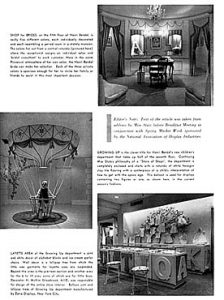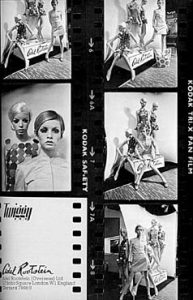From fraternity keg parties and goldfish-swallowing competitions, a new, serious sense of awareness suddenly swept across U.S. college campuses in the mid-1960s. In the wake of a murdered young president, and confronted by civil unrest and an unpopular war, the nation's youth began to ask: “Why?” And since this generation represented the coming-of-age of the Baby Boomer land mass, their questions caused seismic upheaval.
Humanism, self-expression and social revolution were accompanied by a youth-oriented culture seeking enlightenment in music, drugs and rebellion. Aquarius was dawning, and values were changing.
If U.S. youth was tossing off generations of ambivalence, British youth was overturning centuries of an unchanged order. From James Bond movies and Beatles music to Mary Quant miniskirts and Vidal Sassoon hairstyles, it was the “British invasion” that drove the 60s irreverence. Small, independent London shops on Carnaby Street and Kings Road featured the “mod” unisex styles and newfound idyllic decadence, fashion statements that ended up in Sears and JC Penney and on suburban Main Street.
The haute couture hold on fashion loosened. Style no longer revolved around a single trend. Instead, fashion in the decade became a kaleidoscope of inspiration, mirroring myriad experiences in all aspects of life. For the first time, youthful fashion did not follow pre-existing values dictated by an older generation.
In 1966, Adel Rootstein premiered an innovative modern mannequin, with realistic movement and uniquely human qualities. Slim-limbed Twiggy, wiry Sandie Shaw and seductive Luna (the first widely recognized black mannequin) highlighted the Rootstein line and defined a new mannequin attitude.
Advertisement
If the 60s was British insouciance, it was also French stylishness. As Yves St. Laurent began opening small Rive Gauche shops around the fashion world, American merchants adopted the French term boutique for the first time. And large U.S. department stores were soon feeling the effects of this new form of “shop” shopping. In New York, Henri Bendel opened the Haze Glazebrook-designed Street of Shops on its main floor. Inspired by the Via Mizner in Palm Beach, this was the first grouping of boutiques within a single large-store environment.
Youth-oriented shops led to the term “Junior Sportswear” in department stores. Display director Sal Mara installed blue plastic sleeves over fluorescent lights in Alexander's 59th Street Bridge Shop.
Introducing boutiques into the department store format led to a revolution in store planning. The Bonwit Teller store in Eastchester, N.Y., adopted an experimental Center Core floor plan, featuring angles, polygons and curves. This new approach, a dramatic departure from the typical coordinate grid, reduced individual department depths, maximized frontage and enhanced traffic flow. It differentiated the various shops and their unique lifestyle presentations.
In 1964, developers reclaimed a dilapidated 19th Century chocolate factory in the hills overlooking San Francisco Bay, recycling it for retail use while maintaining the integrity of its history and design. Twenty years of suburban flight had reduced the nation's inner cities to rusted exit signs off crumbling highways. But Ghirardelli Square infused new life and an innovative sense of purpose into a once-thriving metropolitan area, and gave retail new in-town possibilities.
The whirlwind that was the 60s had begun with the election of a young president and his glamorous family. It was followed, too soon, by the assassination in Dallas and the Profumo sex scandals in Great Britain.
Folk singers bared their souls and teeny boppers bared their thighs. Uniforms of non-convention – shaggy haircuts, bell-bottoms, bright colors, paisley shapes, Edwardian cuts – became the convention. There was the self-satisfied euphoria of moonwalks, Woodstock and Monterey.
Advertisement
Then the summer of love in San Francisco somehow became the night of bloody helter-skelter in the hills above Los Angeles. Gunmen killed Martin Luther King and Robert Kennedy. In replacing the despised world it had inherited, the 60s generation had exchanged its parents'problems with its own.
In the process, though, a new futurism had been envisioned. Bold lines and dramatic typography were highlighting innovative store environments. Psychedelic images, op art and photographic blow-ups were becoming trademarks of a generation and the hallmark of a retail genre.


 Photo Gallery2 days ago
Photo Gallery2 days ago
 Headlines1 week ago
Headlines1 week ago
 Headlines2 weeks ago
Headlines2 weeks ago
 Sector Spotlight2 weeks ago
Sector Spotlight2 weeks ago
 Headlines1 week ago
Headlines1 week ago
 Headlines3 days ago
Headlines3 days ago
 Headlines2 weeks ago
Headlines2 weeks ago
 Designer Dozen1 week ago
Designer Dozen1 week ago
















